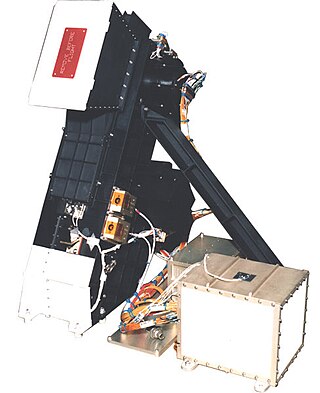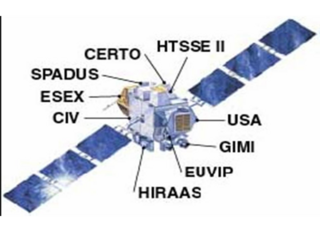
The Geostationary Operational Environmental Satellite (GOES), operated by the United States' National Oceanic and Atmospheric Administration (NOAA)'s National Environmental Satellite, Data, and Information Service division, supports weather forecasting, severe storm tracking, and meteorology research. Spacecraft and ground-based elements of the system work together to provide a continuous stream of environmental data. The National Weather Service (NWS) and the Meteorological Service of Canada use the GOES system for their North American weather monitoring and forecasting operations, and scientific researchers use the data to better understand land, atmosphere, ocean, and climate dynamics.

Space weather is a branch of space physics and aeronomy, or heliophysics, concerned with the time varying conditions within the Solar System, including the solar wind, emphasizing the space surrounding the Earth, including conditions in the magnetosphere, ionosphere, thermosphere, and exosphere. Space weather is distinct from, but conceptually related to, the terrestrial weather of the atmosphere of Earth. The term "space weather" was first used in the 1950s and came into common usage in the 1990s. Later, it was generalized to a "space climate" research discipline, which focuses on general behaviors of longer and larger-scale variabilities and effects.

Galaxy Evolution Explorer was a NASA orbiting space telescope designed to observe the universe in ultraviolet wavelengths to measure the history of star formation in the universe. In addition to paving the way for future ultraviolet missions, the space telescope allowed astronomers to uncover mysteries about the early universe and how it evolved, as well as better characterize phenomena like black holes and dark matter. The mission was extended three times over a period of 10 years before it was decommissioned in June 2013. GALEX was launched on 28 April 2003 and decommissioned in June 2013.
Pegasus is an air-launched launch vehicle developed by Orbital Sciences Corporation (OSC) and now built and launched by Northrop Grumman. Pegasus is the world's first privately developed orbital launch vehicle. Capable of carrying small payloads of up to 443 kg (977 lb) into low Earth orbit, Pegasus first flew in 1990 and remains active as of 2021. The vehicle consists of three solid propellant stages and an optional monopropellant fourth stage. Pegasus is released from its carrier aircraft at approximately 12,000 m (39,000 ft), and its first stage has a wing and a tail to provide lift and attitude control while in the atmosphere. Notably, the first stage does not have a thrust vector control (TVC) system.
Orbital Sciences Corporation was an American company specializing in the design, manufacture, and launch of small- and medium- class space and launch vehicle systems for commercial, military and other government customers. In 2014, Orbital merged with Alliant Techsystems to create a new company called Orbital ATK, Inc., which in turn was purchased by Northrop Grumman in 2018. The remnants of the former Orbital Sciences Corporation today are a subsidiary of Northrop Grumman, known as Northrop Grumman Space Systems.

IMAGE is a NASA Medium Explorer mission that studied the global response of the Earth's magnetosphere to changes in the solar wind. It was believed lost but as of August 2018 might be recoverable. It was launched 25 March 2000, at 20:34:43.929 UTC, by a Delta II launch vehicle from Vandenberg Air Force Base on a two-year mission. Almost six years later, it unexpectedly ceased operations in December 2005 during its extended mission and was declared lost. The spacecraft was part of NASA's Sun-Earth Connections Program, and its data has been used in over 400 research articles published in peer-reviewed journals. It had special cameras that provided various breakthroughs in understanding the dynamics of plasma around the Earth. The principal investigator was Jim Burch of the Southwest Research Institute.

Explorer 32, also known as Atmosphere Explorer-B (AE-B), was a NASA satellite launched by the United States to study the Earth's upper atmosphere. It was launched from Cape Canaveral on a Delta C1 launch vehicle, on 25 May 1966. It was the second of five "Atmosphere Explorer", the first being Explorer 17. Though it was placed in a higher-than-expected orbit by a malfunctioning second stage on its launch vehicle, Explorer 32 returned data for ten months before failing due to a sudden depressurization. The satellite reentered the Earth's atmosphere on 22 February 1985.

The Solar Dynamics Observatory (SDO) is a NASA mission which has been observing the Sun since 2010. Launched on 11 February 2010, the observatory is part of the Living With a Star (LWS) program.

Time History of Events and Macroscale Interactions during Substorms (THEMIS) mission began in February 2007 as a constellation of five NASA satellites to study energy releases from Earth's magnetosphere known as substorms, magnetic phenomena that intensify auroras near Earth's poles. The name of the mission is an acronym alluding to the Titan Themis.

The Global Geospace Science (GGS) Polar satellite was a NASA science spacecraft designed to study the polar magnetosphere and aurorae. It was launched into orbit in February 1996, and continued operations until the program was terminated in April 2008. The spacecraft remains in orbit, though it is now inactive. Polar is the sister ship to GGS Wind.

The Special Sensor Ultraviolet Limb Imager (SSULI) is an imaging spectrometer that is used to observe the earth's ionosphere and thermosphere. These sensors provide vertical intensity profiles of airglow emissions in the extreme ultraviolet and far ultraviolet spectral range of 800 to 1700 Angstrom and scan from 75 km to 750 km tangent altitude. The data from these sensors will be used to infer altitude profiles of ion, electron and neutral density.
Dynamics Explorer was a NASA mission, launched on 3 August 1981, and terminated on 28 February 1991. It consisted of two unmanned satellites, DE-1 and DE-2, whose purpose was to investigate the interactions between plasmas in the magnetosphere and those in the ionosphere. The two satellites were launched together into polar coplanar orbits, which allowed them to simultaneously observe the upper and lower parts of the atmosphere.

The Advanced Research and Global Observation Satellite (ARGOS) was launched on 23 February 1999 carrying nine payloads for research and development missions by nine separate researchers. The mission terminated on 31 July 2003.

C/NOFS, or Communications/Navigation Outage Forecasting System was a USAF satellite developed by the Air Force Research Laboratory (AFRL) Space Vehicles Directorate to investigate and forecast scintillations in the Earth's ionosphere. It was launched by an Orbital Sciences Corporation Pegasus-XL launch vehicle at 17:02:48 UTC on 16 April 2008 and decayed on 28 November 2015.

MAVEN is a NASA spacecraft orbiting Mars to study the loss of that planet's atmospheric gases to space, providing insight into the history of the planet's climate and water. The name is an acronym for "Mars Atmosphere and Volatile Evolution" while the word maven also denotes "a person who has special knowledge or experience; an expert". MAVEN was launched on an Atlas V rocket from Cape Canaveral Air Force Station, Florida, on 18 November 2013 UTC and went into orbit around Mars on 22 September 2014 UTC. The mission is the first by NASA to study the Mars atmosphere. The probe is analyzing the planet's upper atmosphere and ionosphere to examine how and at what rate the solar wind is stripping away volatile compounds.

Energetic Neutral Atom (ENA) imaging, often described as "seeing with atoms", is a technology used to create global images of otherwise invisible phenomena in the magnetospheres of planets and throughout the heliosphere.

Fast, Affordable, Science and Technology Satellite-Huntsville 01 or FASTSAT-Huntsville 01 of the NASA. FASTSAT-HSV 01 was flying on the STP-S26 mission - a joint activity between NASA and the U.S. Department of Defense Space Test Program, or DoD STP. FASTSAT and all of its six experiments flying on the STP-S26 multi-spacecraft/payload mission have been approved by the Department of Defense Space and Experiments Review Board (USA-220).

Global-scale Observations of the Limb and Disk (GOLD) is a heliophysics Mission of Opportunity (MOU) for NASA's Explorers program. Led by Richard Eastes at the Laboratory for Atmospheric and Space Physics, which is located at the University of Colorado Boulder, GOLD's mission is to image the boundary between Earth and space in order to answer questions about the effects of solar and atmospheric variability of Earth's space weather. GOLD was one of 11 proposals selected, of the 42 submitted, for further study in September 2011. On 12 April 2013, NASA announced that GOLD, along with the Ionospheric Connection Explorer (ICON), had been selected for flight in 2017. GOLD, along with its commercial host satellite SES-14, launched on 25 January 2018.
Tandem Reconnection and Cusp Electrodynamics Reconnaissance Satellites (TRACERS) is a planned orbiter mission tasked to study the origins of the solar wind and how it affects Earth. The Principal Investigator is Craig Kletzing at the University of Iowa in Iowa City, Iowa. Not including rideshare costs, TRACERS is funded US$115 million.

Dynamics Explorer 2 was a NASA low-altitude mission, launched on 3 August 1981. It consisted of two satellites, DE-1 and DE-2, whose purpose was to investigate the interactions between plasmas in the magnetosphere and those in the ionosphere. The two satellites were launched together into polar coplanar orbits, which allowed them to simultaneously observe the upper and lower parts of the atmosphere.

















